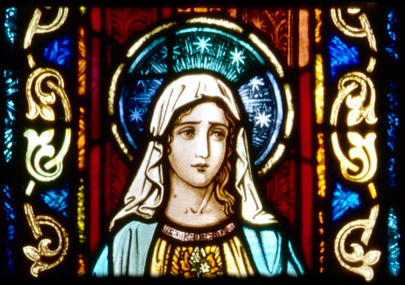of
BLESSED VIRGIN MARY
Chapel
then do what's possible; and
suddenly you are doing the impossible.
- St. Francis of Assisi
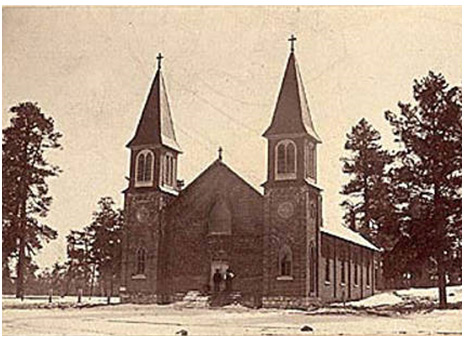
First Nativity Church
Brannen Street – (1888-1911)
Second Nativity Church
Cherry Street – (1911-1930)
Third Nativity Church
Beaver & Cherry Streets – (1930)
Ecclesiastical Jurisdiction
Arizona Territory – 1888
First Nativity Church
Brannen Street – (1888 -1911)
A letter dated Jan. 12, 1887, addressed to Rt. Rev. Bishop Bourgarde - Vicar Apostolic of Arizona at Tucson - over the signatures of John A. Donovan, D. J. Brannen, M.D., and M. J. Riordan - requested a priest be assigned to Flagstaff. The letter further asked permission to build a church, “as there is not a single Catholic church along the entire line of the Atlantic and Pacific line, from Albuquerque to Mojave, California.”
Culminating two years of effort, Flagstaff’s first Catholic church was built in 1888 on the southwest corner of Brannen and Elden Avenues on land donated by P. J. Brannen. The brick building with a pair of matching steeples was named “Church of the Nativity,” commemorating the inaugural services celebrated at midnight Mass on Christmas Eve, 1888. (Coconino Sun sketch, photo 1895)


In 1889, a new bell weighing nearly 1100 lbs., built by the historic McShane & Co. foundry in Baltimore, MD, was purchased. The local newspaper, The Champion, carried a story November 23, 1889, headlined, “The Blessing of the Bell,” stating, “Inscribed in golden letters on the outside of the bell is a Latin verse. The translation reads:

‘I am called the Star of Bethlehem,
And amongst the stars I ring:
Glory to God in High,
Peace and good will to men.’”
The Champion’s news account quotes Fr. Carlo Ferrari, “the energetic builder of this first Nativity Church and celebrant at the first midnight Mass,
‘It is with a gladsome feeling, my dear brethren, that I have performed this ceremony today. I have had inscribed on this new born child (sic), the name “Star of Bethlehem.” The first service was performed in this church on Christmas night and the church is called “The Church of the Nativity,” and in commemorating (sic) of that mysterious star that appeared in the heavens… has this bell been named, and when suspended in this tower may its voice vibrate and reecho through these hills and call many a weary wanderer to the knowledge and love of that Savior, who was born in the grotto of Bethlehem.’”
An early photo of the interior of the Brannen Street church shows a large cross above the altar. (Note the 45 stars on the American flag. Utah became the 45th state in 1896.)
Sometime after 1896, the ornately carved high altar was installed. According to Paul Switzer in an article in The Sun, Sept. 18, 1976, the altar was “fashioned in Flagstaff.”
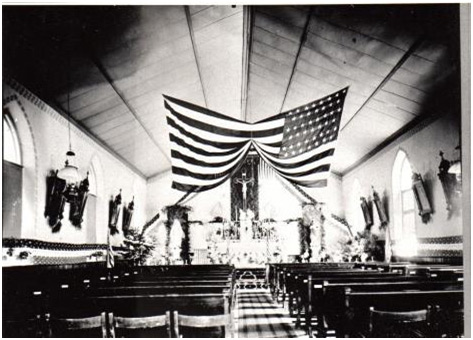
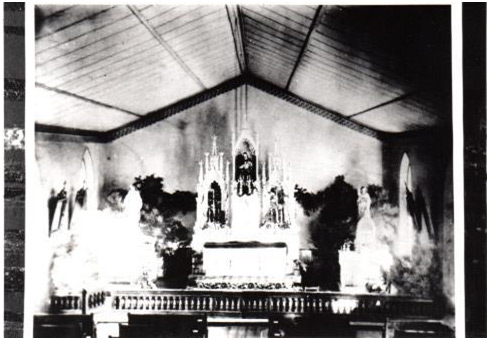
From 1889 to 1911, the bell rang from the tower of the Brannen Street church, when it and other original ‘furniture,’ including the altar and large cross, were moved to the newly built second Nativity Church in the hall at St. Anthony’s School. During this time period, the priests assigned to Nativity parish were: Rev. John J. Dolje (1890-1893), Rev. Joseph Freri (1893-1896), and Rev. Felix Dilly (1897-1900).
Second Nativity Church
Cherry Street – St. Anthony Hall – (1911-1930)
Circa 1898, Rev. Felix Dilly traveled to Bardstown, Kentucky, the mother house of the Sisters of Loretto, to request they undertake the direction of the Catholic school in Flagstaff.
From 1899 to 1903, this house on Beaver Street served as the convent for the Sisters of Loretto. It later became the rectory when a new residence was built for the Sisters in 1903 under the direction of Fr. Cyprian Vabre (parish priest 1900-1924).

The new residence, located on Cherry Street between Humphreys and Beaver Streets, included a chapel, bell tower, two classrooms, and a small grotto.

In 1911, a substantial enlargement of the Sisters’ residence formed St. Anthony’s School, a quadrangular structure with an interior courtyard, additional classrooms, a large hall, and basement.
The Brannen Street church was then vacated, and services moved north to St. Anthony’s School hall. Retaining the name “Church of the Nativity,” the hall served as the parish church from 1911 to 1930. This building, the earlier Brannen Street church (later used as a warehouse), and the original convent no longer exist.
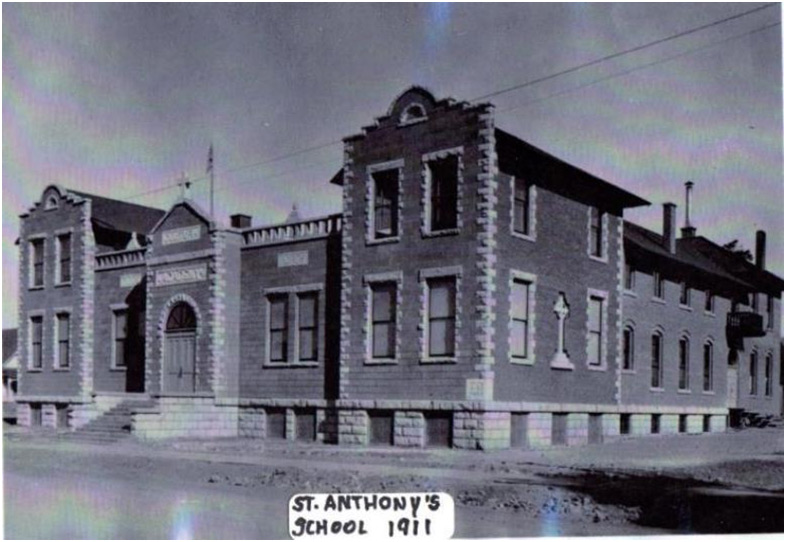
As shown in this photograph of the interior of the St. Anthony School hall, the white altar and other original furnishings were transferred from the Brannen Street church. The “Star of Bethlehem” bell was also relocated from Brannen Street and placed on display at ground level in the interior school courtyard where it remained until 1930. For many years, the sisters in the convent rang the Angelus daily on another smaller bell installed in the courtyard bell tower.
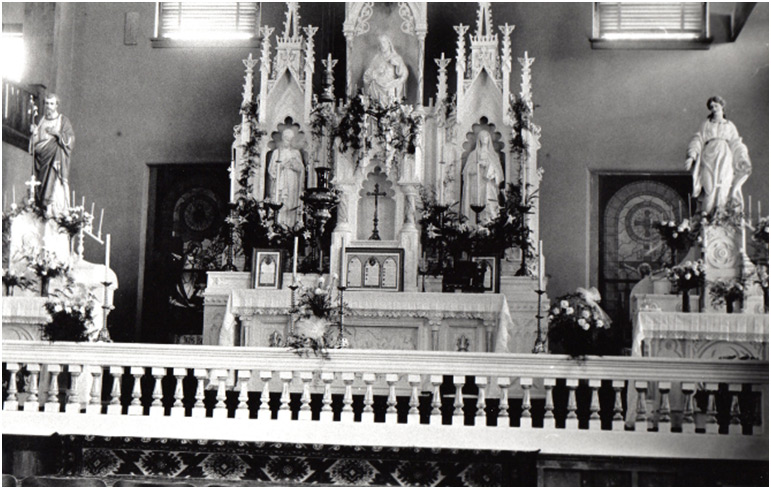
(When the high altar was moved to the third Nativity church in 1930, it was repainted brown with gold highlights. The statue of Mary, shown on the right, replaced The Sacred Heart of Jesus in the central niche, and a beautiful seven-star lighted halo was added to the statue.)
In the spring of 1924, following the death of Fr. C. Vabre, Fr. Edward D. Albouy was transferred from Winslow to Flagstaff, assuming responsibility for the parish. He designed and built a new church in south Flagstaff, Our Lady of Guadalupe (1926), and soon began discussions with parishioners regarding a new, more suitable building to replace the church in St. Anthony’s hall.
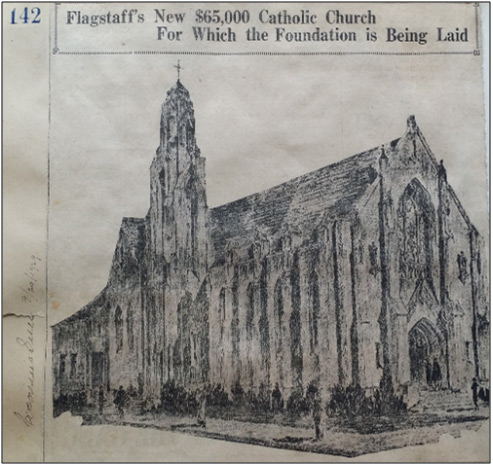
Third Nativity Church
Beaver & Cherry Streets - (1930)
In 1927, planning for a new church to be built on land donated by David Babbitt at the corner of Beaver and Cherry Streets church began in earnest.
The stately church, designed in the Chapel-Gothic style by architect Emmet G. Martin of Los Angeles, was to be constructed of native lichen-covered stone collected by parishioners, “several at a time and by the wagon load.”
The architect submitted water color sketches and construction plans to the parish in April. Foundations were started five months later as proclaimed in the Coconino Sun, September 20, 1929, under the caption “Flagstaff’s New $65,000 Catholic Church for Which the Foundation is Being Laid.”

Although work was suspended through the winter months, on May 18, 1930, with the walls of the church half finished, the cornerstone engraved “Church of the Nativity ~ A.D. 1929,” - complete with a time capsule - was laid.
When the church, petite by Gothic standards, was completed at a cost of nearly $105,000, the Coconino Sun called it “the most beautiful in the state” and “the most artistically perfect structure in Flagstaff,” adding, “competent critics have enthusiastically pronounced it to be the superior, from an artistic standpoint, to any other edifice in the state, if not in the southwest.”

Completed in only 15 months, the dedication of the church by Bishop Daniel J. Gercke of Tucson, took place on Sunday, December 7, 1930.
(The exterior stone work is in good condition, needing only minor repointing of mortar joints in some places. However, the decorative cast stone on the 92-foot bell tower has suffered extensive deterioration. Of the 16 gargoyles, all are severely compromised, many are gone, and the exterior statues and rear chimney are in need of repair.)
READ MORE: The Construction of Nativity Church - 1930
Ecclesiastical Jurisdiction Of Flagstaff
1850
Bishop John B. Lamy
Vicar Apostolic - New Mexico Territory
Became Diocese of Santa Fe in 1853
1863
New Mexico Territory divided;
Arizona Territory formed
Bishop Lamy traveled by horseback through Flagstaff, Dec. 1863.
1868-1885
Bishop John B. Salpointe
Vicar Apostolic - Arizona Territory (plus New Mexico counties)
As Archbishop of Santa Fe visited Flagstaff in 1895.
1885-1899
Bishop Peter Bourgade
Vicar Apostolic - Arizona Territory
Tucson became a diocese in 1897.
Visited Flagstaff 1891 and 1895.
1900-1923
Bishop Henry Granjon
Diocese of Tucson – Arizona Territory, State of Arizona
Served as temporary pastor in Flagstaff in 1895.
1912
Arizona became a state
1923-1939
Bishop Daniel J. Gercke
Diocese of Tucson – State of Arizona
1939-1969
Bishop Bernard T. Espelage, O.F.M.
Diocese of Gallup - Northern Arizona, northwestern New Mexico.
1969-1976
Bishop Edward A. McCarthy
Diocese of Phoenix
Arizona counties: Maricopa, Coconino minus Indian reservations, Mohave, & Yavapai.
1976-1981
Bishop James S. Rausch
Diocese of Phoenix
1981-2003
Bishop Thomas J. O’Brien
Diocese of Phoenix
2003-
Bishop Thomas J. Olmsted
Diocese of Phoenix
- The Diocese of Tucson was created in 1897, and included the Territory of Arizona, a portion of southern New Mexico, and El Paso County, Texas.
- Arizona became a state in 1912. In 1914, the Diocese of Tucson’s boundaries were designated as the entire state of Arizona.
- The previous jurisdiction of southern New Mexico and El Paso County, Texas became the new Diocese of El Paso.
- In 1939, the Diocese of Tucson was divided. Northern Arizona and northwestern New Mexico became the Diocese of Gallup, while southern Arizona remained the Diocese of Tucson.
- In 1969, the Diocese of Phoenix was created by Pope Paul VI. It included Maricopa county, Coconino county minus the Indian reservations, and Mohave and Yavapai counties.
Priests Who Served Nativity Congregation
- 1886-1887 Rev. F. X. Gubitosi, S. J. from Prescott (S.J. - Society of Jesus; formal name for Jesuits)
- 1888-1889 Rev. Carlo M. Ferrari, S. J. from Albuquerque and Prescott
Appointed Pastors Of Nativity Parish
- 1890-1893 - Rev. John J. Dolje
- 1893-1896 - Rev. Joseph Freri
- 1897-1900 - Rev. Felix Dilly
- 1900-1924 - Rev. Cyprian Vabre
Nativity Of Blessed Virgin Mary Parish
- 1924-1952 - Rev. Edward D. Albouy
- 1952-1958 - Rev. Anthony Vorst
- 1958-1976 - Rev. Eugene J. McCarthy
- 1976-1979 - Rev. Vincent Nevulis
- 1979-1982 - Rev. Charles Parker
- 1982-1997 - Rev. J. F. Michael Bain
San Francisco De Asis Parish
- 1997-1998 - Rev. Douglas J. Nohava
- 1998-1999 - Rev. Patrick Robinson, administrator pro tempore
- 1999-2004 - Rev. Michael Straley
- 2004-2018 - Rev. Patrick Mowrer
- 2018-present - Rev. Will Schmid
 Postcards - circa 1930
Postcards - circa 1930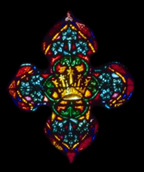
~ Ave Maria ~
